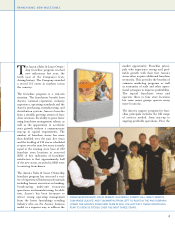Aarons 2002 Annual Report Download - page 20
Download and view the complete annual report
Please find page 20 of the 2002 Aarons annual report below. You can navigate through the pages in the report by either clicking on the pages listed below, or by using the keyword search tool below to find specific information within the annual report.
18
of default, we would be unconditionally liable for a portion of the
outstanding balance of the franchisee’s debt obligations, which
would be due in full within 90 days of the event of default. At
December 31, 2002, the portion which we might be obligated to
repay in the event our franchisees defaulted was approximately
$63.7 million. However, due to franchisee borrowing limits, we
believe any losses associated with any defaults would be mitigated
through recovery of rental merchandise and other assets. Since
its inception, Aaron Rents has had no losses associated with the
franchisee loan and guaranty program.
We have no long-term commitments to purchase merchandise.
See Note G to the Consolidated Financial Statements for further
information.
The following table shows the Company’s approximate obliga-
tions and commitments to make future payments under contractual
obligations as of December 31, 2002:
Period Period Period Period
Less Than 1–3 4–5 Over
(In Thousands) Total 1 Year Years Years 5 Years
Credit facilities,
including
capital leases $ 73,265 $ 277 $18,138 $21,020 $33,830
Operating leases 107,530 33,326 47,678 19,426 7,100
Total
Contractual
Cash
Obligations $180,795 $33,603 $65,816 $40,446 $40,930
The Company has certain commercial commitments related to
franchisee borrowing guarantees and residual values under operat-
ing leases. The Company believes the likelihood of any significant
amounts being funded in connection with these commitments to be
remote. The following table shows the Company’s approximate
commercial commitments as of December 31, 2002:
Total Period Period Period Period
Amounts Less Than 1–3 4–5 Over
(In Thousands) Committed 1 Year Years Years 5 Years
Guaranteed
borrowings of
franchisees $63,700 $63,700
Residual value
guarantee under
operating leases 20,900 20,900
Total
Commercial
Commitments $84,600 $63,700 $20,900
MARKET RISK
Aaron Rents manages its exposure to changes in short-term
interest rates, particularly to reduce the impact on our variable
payment construction and lease facility and floating-rate borrow-
ings, by entering into interest rate swap agreements. These swap
agreements involve the receipt of amounts by us when floating
rates exceed the fixed rates and the payment of amounts by us to
the counterparties when fixed rates exceed the floating rates in
the agreements over their term. We accrue the differential we
may pay or receive as interest rates change, and recognize it as
an adjustment to the floating rate interest expense related to our
debt. The counterparties to these contracts are high credit quality
commercial banks, which we believe minimizes the risk of counter-
party default to a large extent.
At December 31, 2002, we had swap agreements with total
notional principal amounts of $60 million which effectively fixed
the interest rates on obligations in the notional amount of $28
million of debt under our revolving credit agreement, variable
payment construction and lease facility, and other debt at an
average rate of 5.9%, as follows: $20 million at an average rate
of 6.15% until May 2003; $10 million at an average rate of 7.96%
until November 2003; $10 million at an average rate of 7.75% until
November 2003; and an additional $20 million at an average rate
of 7.6% until June 2005. In 2002, we reassigned approximately
$24 million of notional amount of swaps to the variable payment
obligations under our construction and lease facility described
above. Since August 2002, fixed rate swap agreements in the
notional amount of $32 million were not being utilized as a hedge
of variable obligations, and accordingly, changes in the valuation
of such swap agreements are recorded directly to earnings. The
fair value of interest rate swap agreements was a liability of
approximately $3.3 million at December 31, 2002. A 1% adverse
change in interest rates on variable rate obligations would not
have a material adverse impact on the future earnings and cash
flows of the Company.
We do not use any market risk sensitive instruments to hedge
commodity, foreign currency, or risks other than interest rate risk,
and hold no market risk sensitive instruments of any kind for
trading or speculative purposes.
RECENT ACCOUNTING
PRONOUNCEMENTS
In June 2001, the Financial Accounting Standards Board
issued Statement of Financial Accounting Standards No. 141
(SFAS 141), Business Combinations. This statement eliminates the
pooling of interests method of accounting for all business com-
binations initiated after June 30, 2001, and addresses the initial
recognition and measurement of goodwill and other intangible
assets acquired in a business combination. We have had no
significant business combinations after June 30, 2001.
Effective January 1, 2002, we adopted Statement of Financial
Accounting Standards No. 142 (SFAS 142), Goodwill and Other
Intangible Assets. We performed Step 1 of the required transitional
impairment test under SFAS 142 using a combination of the
market value and comparable transaction approaches to business
enterprise valuation. We concluded that the enterprise fair values
of our reporting units were greater than the carrying value,
and accordingly, no further impairment analysis was considered
necessary. We also adopted the non-amortization provisions of
SFAS 142, which resulted in an increase in net earnings of
$688,000 or $.03 diluted earnings per share for 2002.
In August 2001, the Financial Accounting Standards Board
issued Statement of Financial Accounting Standards No. 144
(SFAS 144), Accounting for the Impairment or Disposal of Long-Lived
Assets. This statement supercedes Statement of Financial
























